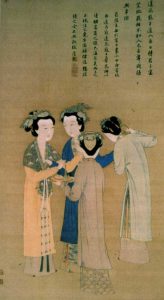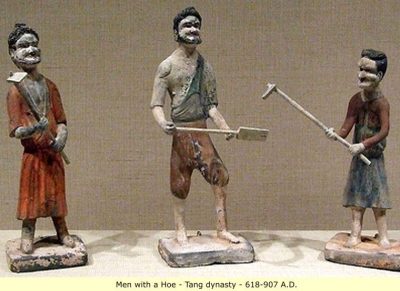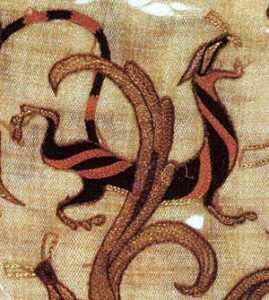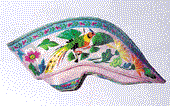
Ming dynasty (1400s AD) painting by Tang Yin
Tunics and padded jackets and pants
People in China generally wore tunics (like long t-shirts). Women wore long tunics down to the ground, with belts, and men wore shorter ones down to their knees. Sometimes they wore jackets over their tunics. In the winter, when it was cold, people wore padded jackets over their tunics, and sometimes pants under them.
Silk and hemp
In early China, poor people made their clothes of hemp or ramie, which is a plant like nettles. Rich people wore silk, and, like the women in this picture, they often wore more than one tunic, in layers.
During the Sui Dynasty, in the 500s AD, the emperor decided that all poor people had to wear blue or black clothes, and only rich people could wear colors. That didn’t last long though, as you can see from the picture of T’ang Dynasty farmers below.
Feather capes
In China’s version of the Cinderella story, her magic fish grants her a feather cape to wear to the Qingming Jie Spring Festival. I think that’s interesting because people also wore feather capes in the Americas.
What were the hairstyles of ancient China?

Chinese clothing and hairstyles: Three farmers from T’ang Dynasty China, 700s AD
Most people in China, both men and women, wore their hair long. People said that you got your hair from your parents and so it was disrespectful to cut it.
Ancestor worship in China
Both men and women wore their hair up in a bun, fastened with wooden or ivory sticks. That kept your long hair out of your way.
What is ivory?
Did men shave their beards in ancient China?
Most men shaved their beards or grew a narrow beard on just their chin, but men in China often grew long mustaches.
When did Chinese embroidery get started?

Han Dynasty embroidery (200 BC-200 AD)
The invention of the steel sewing needle, about 200 BC, made it possible for the first time to do fine embroidery and fine sewing. The steel needles were so thin that they didn’t make big holes in the cloth.
So from the Han Dynasty onward, rich people liked to show off by having a lot of embroidery all over their clothes.
Did people in ancient China get tattoos?
Most people in ancient China thought tattoos were terrible, for the same reason that they didn’t cut their hair: because you got your body from your parents and it was disrespectful to change it. In China, people thought of tattoos as something foreigners did, like people from Central Asia or from Vietnam.

Chinese village doctor treating a man by burning herbs on his back (Song Dynasty, ca. 950 AD., now in National Palace Museum, Taiwan) – or is the doctor trying to remove the man’s tattoos?
Tattoos may have become more common in the Han Dynasty when the new steel needles were invented. But when people in China did get tattoos, it was often because somebody forced them to.
Chinese government officials and slave-owners sometimes tattooed criminals and enslaved people. Tattoos were a way of shaming people and marking them as property. Under the Song Dynasty, the army also tattooed draftees and prisoners of war. Apparently some people used moxibustion – burning bundles of herbs on your skin – to try to get rid of the tattoos.
On the other hand, some people did want to get tattoos. Soldiers sometimes got tattoos of Chinese characters with strong messages like “Serve loyally.” And in some Chinese stories, men do have big colored tattoos of dragons and fairies, though other people look down on them for it.
Foot-binding in medieval China
In the Song Dynasty, about 1100 AD, a fashion started at the emperor’s court for women to bind their feet. Women thought that to be beautiful they needed little tiny feet, only about three inches long. They got these tiny feet by wrapping tight bandages around the feet of little girls, about five or six years old.
Song Dynasty clothing

An embroidered shoe for someone with bound feet
The bandages were so tight they broke the girls’ toes and bent them underneath their feet and then they had to walk on them like that. The girls spent most of their time crying for two or three years and then the feet stopped hurting so much. Women with bound feet couldn’t walk very well at all, and when they had to work in the fields often they would crawl.
Cinderella and bound feet
Some early versions of the story of Cinderella come from Song Dynasty China. In these versions, the point of the story is that the Prince loves Cinderella because she has the smallest feet of any girl in the kingdom, so the slipper will only fit her.
Foot-binding and child labor
But bound feet weren’t really all about beauty. Many families chose to bind girls’ feet because bound feet forced young girls to sit still all day, and then they would spin and weave more cloth for the family to sell. Making cloth was a way families could get money for food and rent, so foot-binding was popular for that reason too.
A video about foot-binding
Cotton comes to China
Then in the Yuan Dynasty, the Mongols brought cotton to China. At first people didn’t want to grow cotton, maybe because the people running the silk industry wanted to keep people buying silk. But the Mongol invasions in the 1200s destroyed a lot of the mulberry trees that were needed to make silk.
The Mongols in China
The Mongol emperors, like Kublai Khan, turned to cotton to fill the gap. In 1289 AD they ordered the opening of special training centers to teach farmers how to grow cotton. And in 1296 they ordered that farmers who grew cotton could pay lower taxes.
History of cotton
Soon everyone liked cotton better than ramie or hemp. Cotton was warmer, and softer, and stronger, and cheaper. You could make it thin for summer, or you could make thick padded clothes out of it that were warm for winter.
